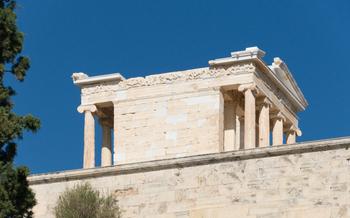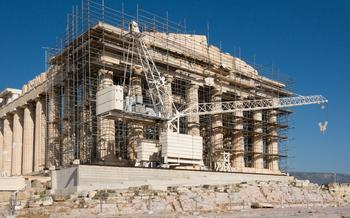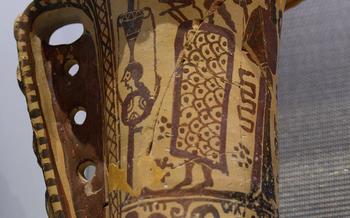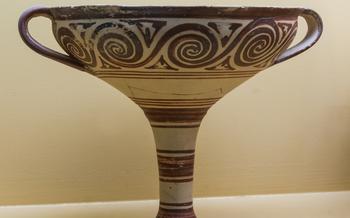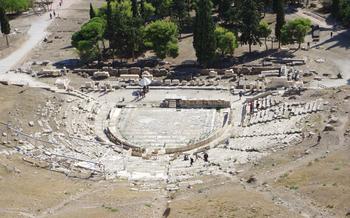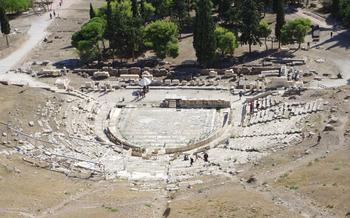
Areopagus Hill
- Acropolis Views
- Rich Historical Significance
- The Areopagus Council
- Mars Hill
- Ancient Greek Democracy
- Philosophical Debates
- The Apostle Paul
- Beautiful Panoramic Views
- Temple of Ares
- Ancient Theater of Dionysus
- Ancient Greek Mythology
- Psyrri Neighborhood
- Insider Tip: Take a Guided Tour
- The Areopagus Museum: A Journey Through History and Archaeology
- Insider Tip: Best Time to Visit
Acropolis Views
The Areopagus, also known as Mars Hill, offers breathtaking views of the Acropolis, the ancient citadel that dominates the Athenian skyline. Ascend the hill and marvel at the architectural wonders of ancient Greece, including the Parthenon, the Erechtheion, and the Temple of Athena Nike. Imagine ancient Greek philosophers, such as Socrates, Plato, and Aristotle, debating and discussing ideas in this very spot. For a truly picturesque moment, visit the Areopagus at sunset when the golden light casts a warm glow over the Acropolis, creating a stunning photo opportunity.
Rich Historical Significance
The Areopagus holds immense historical significance, attracting visitors from around the world. In 50 AD, the apostle Paul, a pivotal figure in Christianity, addressed the Athenians on this very hill. His sermon, recorded in the book of Acts in the Bible, marked a pivotal moment in the spread of Christianity.
Explore the Site's Historical Significance
As you explore the Areopagus, let history come alive. Imagine yourself transported back in time, witnessing St. Paul delivering his powerful message to the Athenian people. Feel the weight of his words as he spoke of the one true God and the resurrection of Jesus Christ.
Immerse Yourself in the Footsteps of History
Stand where St. Paul once stood and soak in the atmosphere of this sacred site. Imagine the impact his words had on those who heard him, and consider how his teachings shaped the course of history. Reflect on the enduring legacy of Christianity and its profound influence on Western civilization.
Insider Tip: Read Up on Ancient Greek History
To fully appreciate the significance of the Areopagus, it's helpful to have some background knowledge of ancient Greek history and culture. Familiarize yourself with the political and religious landscape of Athens during St. Paul's time. This will enhance your understanding of the context and impact of his sermon.
The Areopagus Council
The Areopagus played a pivotal role in the ancient Athenian democracy, serving as the supreme court and decision-making body. Imagine yourself transported back in time, witnessing the council members deliberating on crucial matters that shaped the course of Athenian history. Visualize the orators presenting their cases, the judges carefully considering the evidence, and the final verdicts being reached.
Insider Tip: Before your visit, delve into the history of the Areopagus Council. Learn about its composition, the selection process of its members, and the wide range of cases it handled. This knowledge will enhance your understanding and appreciation of the council's significance in ancient Athenian society.
Mars Hill
The Areopagus is also known as Mars Hill, a name derived from its association with the Greek god of war, Ares. In ancient Greek mythology, Ares was worshipped on this very spot, and the hill held great religious significance. Explore the hill's mythological and historical significance, and imagine ancient Greeks worshipping Ares on this very spot.
Visit the nearby Temple of Hephaestus, located just a short walk from the Areopagus, to learn more about Greek mythology and the significance of Ares in ancient Greek culture. The temple, dedicated to the god of fire and metalworking, offers a glimpse into the religious beliefs and practices of ancient Athens.
Ancient Greek Democracy
Ancient Greek democracy, as practiced in Athens, stood as a pioneering system of government that laid the foundation for modern democratic ideals. One of the earliest forms of democracy, it originated in the 6th century BC and flourished for over 200 years.
The Areopagus played a crucial role in the functioning of ancient Athenian democracy. It served as the city's highest court, overseeing matters of religion, morality, and state security. The council was composed of former archons, who were elected officials who had completed their term of office.
Imagine yourself participating in an ancient Greek assembly, where citizens debated and voted on important issues affecting their city. The Areopagus Council held significant influence in these assemblies, providing guidance and ensuring that decisions aligned with Athenian law and tradition.
To delve deeper into the fascinating world of ancient Greek democracy, consider visiting the nearby Agora, the center of political and commercial life in ancient Athens. Explore the ruins of government buildings, marketplaces, and temples, where the foundations of democracy were laid.
Insider Tip: Enhance your visit to the Areopagus by reading books like "The Landmark Thucydides" or "The Greek Way" to gain a deeper understanding of ancient Athenian democracy.
Philosophical Debates
The Areopagus was not just a place of legal proceedings but also a hub for philosophical discussions and debates. Ancient Greek philosophers, such as Socrates, Plato, and Aristotle, frequently gathered here to exchange ideas and engage in intellectual discourse on various topics, including politics, ethics, and the nature of reality.
Imagine yourself transported back in time, sitting among these great minds, listening to their arguments and counterarguments, and participating in the lively debates that shaped the course of Western thought. The Areopagus was a place where ideas were challenged, new perspectives were explored, and the foundations of modern philosophy were laid.
To fully appreciate the significance of these debates, it's helpful to read up on ancient Greek philosophy before your visit. This will provide you with a deeper understanding of the concepts and ideas that were discussed on the Areopagus, allowing you to engage with the site on a more meaningful level.
The Apostle Paul
St. Paul, a pivotal figure in the history of Christianity, graced the Areopagus with his presence in 50 A.D. His sermon, documented in the book of Acts, marked a significant moment in the spread of Christianity. Paul's eloquent words resonated with the Athenians, introducing them to the teachings of Jesus Christ.
Imagine yourself transported back in time, standing among the ancient Greeks as Paul delivered his powerful sermon. His voice echoed across the hill, captivating the attention of his audience. His message of hope, redemption, and eternal life left an indelible mark on the hearts of many.
To fully appreciate the significance of Paul's sermon, it is essential to understand the context of ancient Athens. The city was renowned for its intellectual prowess and philosophical debates. Paul's message, therefore, challenged the prevailing ideologies of the time, offering a new perspective on life and spirituality.
Follow in the footsteps of St. Paul by visiting the Areopagus and immersing yourself in the historical significance of this site. Allow your imagination to soar as you envision Paul standing on this very spot, sharing his transformative message with the Athenians.
Insider Tip: To enhance your experience, consider visiting the nearby Mars Hill Church, built on the site where St. Paul is believed to have delivered his sermon. The church offers a unique opportunity to connect with the legacy of St. Paul and the early Christian community in Athens.
Beautiful Panoramic Views
The Areopagus Hill offers breathtaking panoramic views of Athens and the surrounding landscape. Its strategic location provided ancient Greek soldiers with a vantage point to survey the land for defense purposes. Today, visitors can enjoy stunning vistas of the city, including landmarks such as the Acropolis, the Temple of Hephaestus, and the Ancient Agora. The hilltop also offers a unique perspective of the surrounding mountains and the Saronic Gulf. Whether you're a history buff, a nature lover, or simply looking for a spot to relax and take in the beauty of Athens, the Areopagus Hill is a must-visit destination.
Anecdote:
Imagine yourself as an ancient Greek soldier standing atop the Areopagus, scanning the horizon for potential threats. The sun is setting, casting a golden glow over the city below. You feel a sense of pride and responsibility as you survey the land, knowing that you are part of something larger than yourself.
Insider Tip:
Visit the Areopagus Hill at night for a spectacular view of the illuminated city. The Acropolis and other landmarks are beautifully lit up, creating a magical atmosphere that is not to be missed.
Temple of Ares
The Temple of Ares was a prominent structure located atop the Areopagus Hill in ancient Athens. Dedicated to the Greek god of war, Ares, the temple was built in the 5th century BC and served as a significant religious and cultural site. Although only ruins remain today, the temple's history and significance continue to captivate visitors.
Explore the Temple's Ruins
As you approach the Areopagus Hill, the ruins of the Temple of Ares stand as a testament to its former grandeur. While only fragments of the temple's once-magnificent structure remain, you can still discern its original layout and design. Imagine the temple in its prime, adorned with intricate sculptures and vibrant colors, serving as a focal point for religious ceremonies and festivals honoring Ares.
Imagine Ancient Greek Worship
In ancient times, the Temple of Ares was a place of worship and devotion for the Athenians. Imagine ancient Greek citizens gathering within the temple's sacred walls, offering sacrifices and prayers to Ares, seeking his favor and protection in times of war and conflict. The temple's strategic location atop the hill allowed for a commanding view of the city and its surroundings, symbolizing Ares's watchful presence over Athens.
Visit the Acropolis Museum
To further immerse yourself in the history of the Temple of Ares, visit the nearby Acropolis Museum. Here, you can admire artifacts and sculptures that once adorned the temple, providing a glimpse into its architectural and artistic splendor. The museum's collection offers a deeper understanding of the temple's significance within the context of ancient Greek religion and culture.
Ancient Theater of Dionysus
Theoretical: The Ancient Theater of Dionysus, nestled at the foot of the Areopagus, is a remarkable relic of ancient Greek culture. Dedicated to the god Dionysus, the patron of wine, theater, and fertility, this theater holds immense historical and cultural significance.
Practical: Explore the theater's awe-inspiring ruins, where ancient Greek dramas were once performed before enthusiastic audiences. Imagine the vibrant atmosphere as thespians brought to life the works of renowned playwrights like Sophocles, Euripides, and Aristophanes.
Anecdote: Picture yourself transported back in time, witnessing a performance of "Oedipus Rex" or "Medea," surrounded by an eager crowd, captivated by the power of ancient Greek storytelling.
Insider Tip: Complement your visit by exploring the Acropolis Museum, which houses fascinating artifacts from the theater, providing a glimpse into the artistic and cultural achievements of ancient Athens.
Ancient Greek Mythology
The Areopagus is deeply embedded in ancient Greek mythology, serving as a stage for legendary tales and divine interactions. According to myth, the hill was named after Ares, the Greek god of war, who was believed to have been tried here by the twelve Olympian gods for the murder of Halirrhothius, the son of Poseidon, the god of the sea. In another myth, the Amazons, a fierce tribe of female warriors, laid siege to Athens and camped on the Areopagus, only to be defeated by Theseus, the mythical king of Athens. These myths add a layer of enchantment to the Areopagus, inviting visitors to delve into the captivating world of ancient Greek storytelling.
Psyrri Neighborhood
Psyrri, a vibrant neighborhood located at the foot of the Areopagus Hill, is a must-visit for those seeking a taste of authentic Athenian life. With its charming narrow streets adorned with colorful graffiti, lively bars, and delectable restaurants serving traditional Greek cuisine, Psyrri exudes an infectious energy that draws visitors from all walks of life.
Strolling through Psyrri in the evening is an experience in itself. The streets come alive with the sounds of laughter, music, and the clinking of glasses as locals and tourists alike gather to enjoy the neighborhood's vibrant atmosphere. From cozy tavernas serving mouth-watering souvlaki to trendy cocktail bars offering innovative libations, Psyrri has something to suit every taste and budget.
For those seeking unique souvenirs, the nearby Flea Market is a treasure trove of vintage clothing, antiques, and handmade crafts. Whether you're looking for a one-of-a-kind piece of jewelry, a quirky home décor item, or simply a bargain, the Flea Market is a great place to explore and find hidden gems.
Insider Tip: Take a Guided Tour
To fully appreciate the rich history and significance of the Areopagus Hill, consider taking a guided tour. Knowledgeable guides will provide fascinating insights into the hill's ancient past, from its role as the supreme court of ancient Athens to its association with the Greek god Ares and the Apostle Paul's sermon.
Guided tours typically cover all the major highlights of the Areopagus, including the Areopagus Council, the Temple of Ares, and the Ancient Theater of Dionysus. They also offer a deeper understanding of the hill's connection to ancient Greek mythology, philosophy, and democracy.
By taking a guided tour, you'll gain a more comprehensive understanding of the Areopagus Hill and its enduring legacy. So, whether you're a history buff, a lover of ancient Greek culture, or simply someone looking for a unique and enriching experience, a guided tour is highly recommended.
The Areopagus Museum: A Journey Through History and Archaeology
Immerse Yourself in the Past
At the foot of the Areopagus Hill, nestled amidst the vibrant streets of Athens, lies a treasure trove of history and archaeology—the Areopagus Museum. This captivating museum invites you on a journey through time, unveiling the secrets of this ancient site and its surrounding area.
Explore Fascinating Exhibits
As you step inside the museum, you'll be greeted by a wealth of exhibits that bring the past to life. Discover ancient artifacts, pottery, and sculptures that tell the story of the Areopagus from its earliest origins to its role in ancient Athenian democracy and beyond.
Uncover Archaeological Wonders
The museum's collection includes a remarkable array of archaeological finds that shed light on the daily lives of the ancient Athenians. From tools and weapons to household objects and religious offerings, these artifacts provide a glimpse into the rich tapestry of ancient Greek culture.
Learn from Experts
To enhance your museum experience, take advantage of the guided tours led by knowledgeable experts. These passionate guides will share their insights and expertise, bringing the history of the Areopagus to life and helping you connect with the stories behind the artifacts.
Insider Tip: A Unique Perspective
For an even more immersive experience, visit the museum during the evening hours. As the sun sets and the crowds disperse, you'll have the opportunity to explore the exhibits in a tranquil and intimate setting, allowing you to fully appreciate the museum's treasures.
Insider Tip: Best Time to Visit
When planning your visit to the Areopagus, timing is everything.
To ensure the most enjoyable experience, consider visiting during the shoulder seasons (spring and fall). During these times, the weather is generally mild and pleasant, with fewer crowds to contend with. You'll be able to fully appreciate the beauty and tranquility of the site without feeling rushed or overwhelmed.
Avoid the summer months (June, July, and August) if possible, as temperatures can soar, making it uncomfortable to explore the hilltop. Additionally, the influx of tourists during this peak season can make it difficult to fully immerse yourself in the historical and cultural significance of the Areopagus.
By visiting in the shoulder seasons, you'll have the opportunity to explore the site at your own pace, take in the breathtaking views, and truly connect with the rich history and philosophical legacy of the Areopagus.

